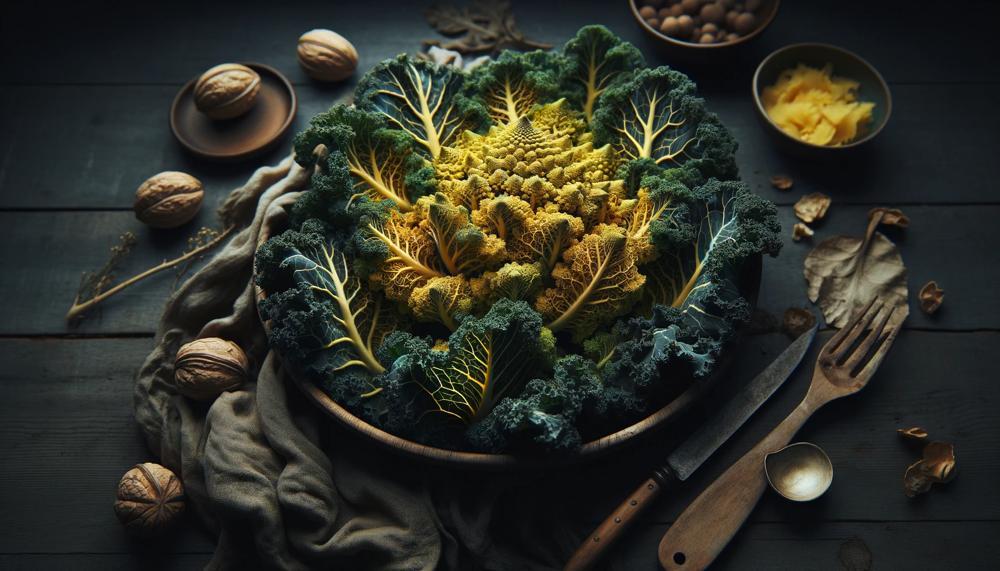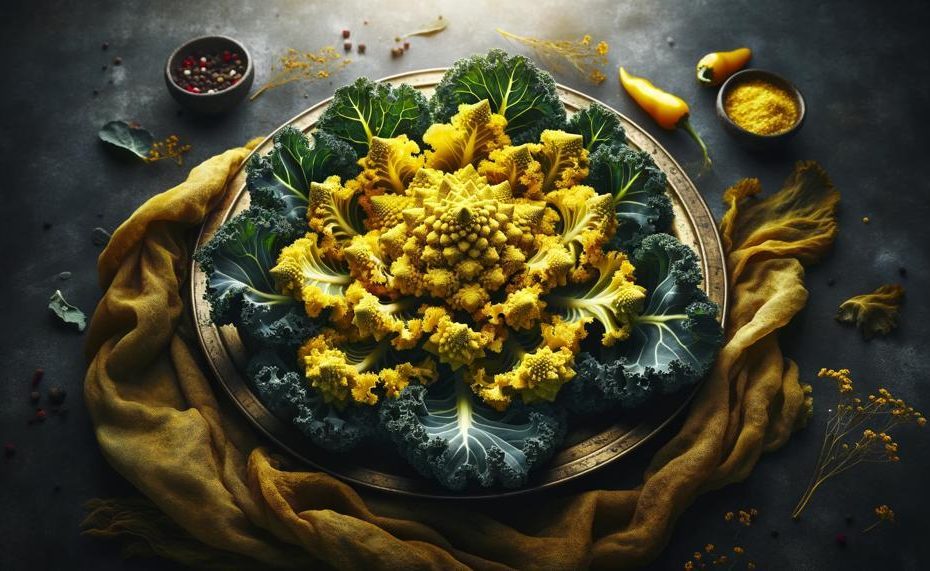Are you tired of the same old kale salads? Looking for a new way to boost your health and add some variety to your meals? Well, get ready to be pleasantly surprised because we have an intriguing twist on the classic green kale – yellowed kale.
Before you turn up your nose at the thought of eating wilted and discolored greens, let us enlighten you. Yellowed kale may not look as vibrant as its green counterpart, but it has some surprising benefits that make it worth trying out.
So, can you eat kale that has turned yellow?
Yes, kale that has turned yellow is usually safe to eat. However, it may have a slightly bitter or tougher flavor than fresh kale. Cooking yellow kale in soups, stews, or sautés can improve its flavor and texture.
So now that we’ve piqued your interest, why not give yellowed kale a chance? In this blog post, we’ll delve deeper into its health benefits and share some delicious ways to incorporate it into your diet.
Let’s get started.
Contents
Why It Turned Yellow?
Kale turns yellow when the chlorophyll in its leaves starts to break down. This can happen due to various factors, such as exposure to air, heat, light, or prolonged storage. As the chlorophyll breaks down, the green color of the leaves fades, resulting in a yellow hue.
Is it Safe to Eat Yellowing Kale?
The good news is that yellowing kale is still safe to eat. The yellow color is simply a sign of age and does not necessarily mean that the kale has gone bad.
However, it is crucial to note that eating a large amount of yellow kale can interfere with iodine synthesis and thyroid functioning. Therefore, it is best to consume fresh and green kale.
Different Ways to Use Yellowing Kale:
While yellowing kale may not look as appetizing as fresh green kale, there are still ways to use it in your cooking. One option is to make kale chips by baking or air frying the leaves until they are crispy. The yellowing will not significantly affect the taste of the chips.
Another option is to incorporate the kale into recipes where it can be hidden or blended, such as soups or smoothies. You can also try reviving limp kale by cutting off the ends and soaking them in warm water before storing them in the refrigerator.
Tips for Preventing Kale from Turning Yellow:

To prevent your kale from turning yellow quickly, store it in the refrigerator. This will slow down the breakdown of chlorophyll and keep the leaves fresh for longer periods.
Additionally, using the warm water technique mentioned above can also help keep your kale fresh and green.
Can You Still Eat It?
It is generally safe to consume yellow kale, but it may not offer the same nutritional benefits and taste as its green counterpart. However, before consuming it, be sure to thoroughly inspect the kale for any signs of rot or mold.
| Why does kale turn yellow? | Kale turning yellow is a natural part of its growing process. As the plant matures, the leaves lose their vibrant green hue and start to turn yellow. This is because the chlorophyll in the leaves breaks down, revealing other pigments such as carotenoids and xanthophylls. |
| How to prevent kale from turning yellow? | To ensure that your kale stays fresh and green, proper storage is key. Keep it in a plastic bag or container with some moisture in the refrigerator. You can also extend its shelf life by blanching and freezing it. |
| What to do with yellowing kale in cooking? | If your kale has already turned yellow, you can still use it in cooking. However, keep in mind that it may not be as flavorful or nutritious as fresh green kale. You can incorporate it into soups, stews, smoothies, or sauté it with other vegetables. |
While consuming yellow kale may not pose any harm, it is best to opt for fresh green kale to reap its full nutritional benefits and taste.
Air Fryer Kale Chips
Looking for a tasty and healthy substitute for processed potato chips? Look no further than air fryer kale chips. These guilt-free snacks are not only delicious, but they are also suitable for vegans, those with nut allergies, and individuals following gluten-free or paleo diets.
In this section, we will explore how you can use an air fryer to make these tasty snacks.
Ingredients:
- 1 bunch of curly or lacinato/dinosaur kale
- 1 tablespoon of nutritional yeast
- Salt and pepper to taste
Instructions:
- Thoroughly wash and dry the kale, removing the tough stems and tearing the leaves into bite-size pieces.
- In a bowl, mix the kale with nutritional yeast, salt, and pepper until evenly coated.
- Preheat your air fryer to 300°F (150°C).
- Place the kale in the air fryer basket in a single layer. For extra caution, use a trivet or pack the chips tightly to prevent them from flying around due to their light weight.
- Cook for 5 minutes, then shake the basket and cook for an additional 5 minutes.
- Check on the chips and continue cooking for another 2-3 minutes if they are not crispy enough.
- Once crispy, remove the chips from the air fryer and let them cool for a few minutes before enjoying.
Storage:
To keep your air fryer kale chips fresh and crispy, store them in an airtight container or brown paper bag for up to 3 days. If they start to lose their crispiness, simply put them back in the air fryer for a few minutes to re-crisp them.
For longer shelf life, you can also use silica gel packs or vacuum-sealed storage bags. However, it is important to note that storing the chips in hot climates may affect their crispiness.
🥣 Other Uses for Yellow Kale
Yellow kale is a versatile and nutritious superfood that can be incorporated into meals in creative and delicious ways. From breakfast to dinner, there are endless possibilities for adding yellow kale to your diet.
Some ideas include making savory dishes like kale hummus, sautéed kale, or kale pesto pizza. For a sweet and nutritious treat, try blending yellow kale into smoothies or adding it to baked goods like muffins or pancakes. Other options include using it as a topping for avocado toast or adding it to soups or stews. You can even make crispy kale chips as a healthy snack.
With its abundance of vitamins and minerals, yellow kale not only benefits your health but also adds flavor and texture to any dish. So next time you’re looking for a new recipe to try, consider incorporating this green superfood into your meal.
What if it’s Limp
The answer is yes, as long as it is cooked correctly. While the depletion of chlorophyll causes kale to turn yellow, it does not affect its nutritional value. In fact, yellow kale contains the same amount of vitamins and minerals as green kale. However, it is important to properly cook the yellowed leaves, as they can have a slightly bitter taste. This can be achieved by sautéing, roasting, or adding them to soups and stews.
If you have noticed your garden’s kale turning yellow and wilting, it is crucial to determine the cause. This could be due to excessive exposure to sunlight, lack of nutrients in the soil, or infestations of pests and diseases. To prevent this from happening in the future, make sure to provide adequate shade for your kale plants and regularly fertilize the soil.
Additionally, inspect your plants frequently for any signs of pests or diseases and take necessary action to control them.
To make the most out of your yellowed kale, here are some storage and cooking tips:
Storing Yellowed Kale:
- Keep yellowed kale in a plastic bag in the refrigerator for up to 5 days.
- Wash and dry the leaves before storing to prevent moisture buildup.
- For longer storage, blanch and freeze the leaves.
Cooking Yellowed Kale:
- Quickly sauté in a pan with garlic and olive oil for a delicious side dish.
- Add to stir-fries or soups for added nutrition and texture.
- Roast in the oven with olive oil, salt, and pepper for crispy kale chips.
- Blend into smoothies for an extra boost of nutrients.
🚫 How to Keep It From Turning Yellow?
There are various effective techniques for keeping kale from turning yellow and preserving its freshness, including proper storage, freezing, blanching, and regularly checking for signs of infection or disease. Below are detailed steps for each method:
Proper Storage:
| Step 1: | Store kale in a bag or container in the refrigerator without completely sealing it to allow for consistent airflow. |
| Step 2: | Avoid storing kale in the coldest parts of the fridge and instead keep it in the crisper drawer where it is slightly warmer. |
| Step 3: | Do not wash the harvest before storing to prevent excess moisture, which can lead to quick rotting. |
| Step 4: | If kale is limp, revive it by cutting the ends and submerging it in warm water before storing it in the fridge. |
Freezing:
| Step 1: | Rinse fresh kale thoroughly and remove stems. |
| Step 2: | Place kale in zip-top storage bags and store in the freezer for up to 4-6 weeks. |
| Step 3: | Prior to cooking or adding to a smoothie, defrost frozen kale. |
Blanching:
| Step 1: | Boil a pot of water and blanch kale leaves for 2-3 minutes. |
| Step 2: | Remove kale from boiling water and immediately plunge into ice water to halt the cooking process. |
| Step 3: | Thoroughly dry the blanched kale and place it in zip-top storage bags. |
| Step 4: | For an extended shelf life, store in the freezer for up to one year. |
Monitoring:
| Step 1: | Regularly check kale plants for signs of infection or disease, such as yellowing leaves. |
| Step 2: | If infected, remove the affected leaves to prevent potential illness from consuming them. |
To summarize, proper storage, freezing, blanching, and monitoring for signs of infection are all effective methods for keeping kale from turning yellow and maintaining its freshness.
Other Posts You Should Check Out
| Blog Post Title | A Kale Kompilation: Discover the Power of this Superfood | Link |
| The Health Benefits of Kale: What Science Says | Uncovering the Nutritious Truth About Kale: What Science Has to Say | https://www.healthline.com/nutrition/10-proven-benefits-of-kale |
| How to Incorporate More Kale into Your Diet | Kale-tastic Tips: How to Sneak more of this Superfood into Your Diet | https://www.eatthis.com/how-to-use-kale/ |
| The Truth About Goitrogens in Kale | Kale Controversy: Separating Fact from Fiction on Goitrogens and Thyroid Health | https://www.furtherfood.com/goitrogens-kale-thyroid-health/ |
| Kale vs. Other Leafy Greens: Which Is Healthier? | Kale, Spinach, or Collards: Which Super Green Reigns Supreme? | https://www.goodhousekeeping.com/health/diet-nutrition/a20707037/kale-vs-spinach-nutrition/ |
| Kale: Raw vs. Cooked | To Cook or Not to Cook? The Debate Over the Best Way to Enjoy Kale’s Benefits | https://www.eatright.org/food/vitamins-and-supplements/types-of-vitamins-and-nutrients/the-benefits-of-raw-vs-cooked-veggies |
Air Fryer Kale Chips
Looking for a quick and easy snack that is both crispy and healthy? By using an air fryer, you can preserve the important vitamins and minerals found in kale, making it a nutritious alternative to traditional potato chips.
Keep reading to discover how to use an air fryer to create delicious, crispy, and healthy kale chips.
HOW TO MAKE AIR FRYER KALE CHIPS:
- Begin by choosing fresh, organic kale from your local grocery store or farmers market.
- Thoroughly wash the kale and completely dry it with a salad spinner or paper towels.
- Remove the tough stems from the kale leaves and tear them into bite-sized pieces.
- In a large mixing bowl, toss the kale with your preferred oil (such as olive oil or avocado oil) and seasoning.
- Place the seasoned kale in a single layer in the air fryer basket.
- Set the air fryer to 375°F and cook for 5-7 minutes, shaking the basket halfway through cooking time.
- Check for desired crispiness and cook for an additional 1-2 minutes if needed.
- Once done, remove the chips from the air fryer and let them cool for a few minutes before serving.
SEASONING VARIATIONS:
- Parmesan and Garlic: Toss kale with grated parmesan cheese, garlic powder, salt, and pepper.
- Ranch: Mix together ranch seasoning mix with olive oil and drizzle over kale before cooking.
- Honey Mustard: Whisk together honey, Dijon mustard, and olive oil then toss with kale before cooking.
- Barbecue: Combine smoked paprika, chili powder, cumin, and garlic powder then sprinkle over kale before cooking.
- Buffalo: Toss kale with hot sauce, ranch seasoning mix, and olive oil before cooking.
- Taco: Mix together chili powder, cumin, garlic powder, and salt then sprinkle over kale before cooking.
- Lemon Pepper: Toss kale with lemon juice, olive oil, and freshly cracked black pepper before cooking.
- Everything Bagel: Sprinkle a mixture of poppy seeds, sesame seeds, dried minced onion, dried minced garlic, and salt over kale before cooking.
- Spicy Cinnamon: Combine cinnamon, cayenne pepper, and salt then sprinkle over kale before cooking.
TIPS FOR ACHIEVING THE PERFECT TEXTURE:
- Use a salad spinner to thoroughly dry the kale before cooking to avoid soggy chips.
- Cook in small batches for even crisping.
- Use a light coating of oil to prevent greasiness.
- Monitor closely towards the end of cooking time to prevent burning.
Also Read: Does Margarita Mix Go Bad?
Conclusion
In conclusion, do not underestimate the power of yellowed kale.
Though it may not have the vibrant green hue we associate with freshness, it still packs a punch when it comes to health benefits. And not only that, incorporating yellowed kale into your meals can also be a budget-friendly and sustainable choice.
So next time you come across some yellowing leaves in your bunch of kale, do not hesitate to give them a chance. Whether you blend them into smoothies, add them to soups or stir-fries, or simply sauté them as a side dish, yellowed kale is a versatile and nutritious addition to any meal.
With proper storage and cooking techniques, you can enjoy this superfood without worrying about its color.





